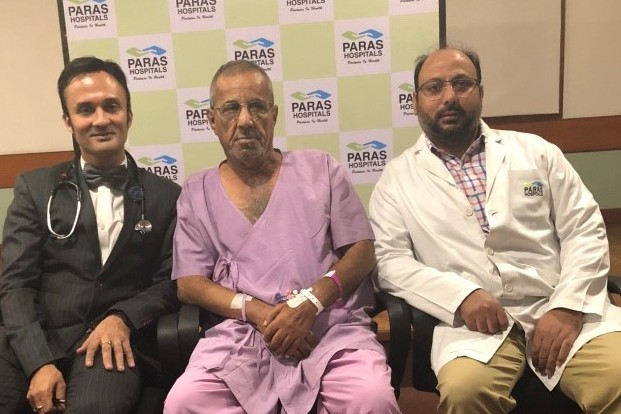Apr 25, 2022
70 yr old Iraqi patient treated for cardiac disease and gangrene in both the feet treated concomitantly with–Specialized Endovascular technique performed by Dr Amit Bhushan Sharma at Paras Hospitals, Gurgaon

The doctors at Paras Hospitals, Gurgaon were together able to effectively treat a non healing gangrenous ulcer of a 70 yr old Iraqi patient, without the use of amputation. The treatment included the for the first time simultaneous management of the patient’ sprecarious heart condition along with treatment of both legs which had non healing gangrenous ulcers .The procedures and the management of the disease were performed by Dr Amit Bhushan, Unit Head and Associate Director – Interventional Cardiology – Paras Hospitals, Gurgaon.

Mr Shabeer reported to the hospital with pain in the lower limb and a non-healing ulcer in the left toe and gangrene in right leg. He was 70 years old, diabetic hypertensive and a chain smoker. Patient was in septicemia with gangrene in the left toe and gangrene in tight leg with exertion alangina. His Coronary Angiography revealed 95 % blockage in the proximal LAD ( a main artery responsible for carrying blood) and 95 % blockage in the right coronary artery. His Peripheral Angiogram revealed 100 % blockage in left SFA and 99 percent blockage in right SFA and totally occluded anterior tibial on left side.
Dr Amit Bhushan leading interventional cardiologist, TAVR specialist and peripheral artery disease (PAD) specialist highlighted that the ulcer and the heart disease were interconnected. The patient and his family members had gone to numerous vascular surgeons to discuss the case, however due to the risk of the coexisting heart blockages and risk of sudden cardiac death they declined from performing any surgery. The surgeons implied that the patient had a strong chance of suffering from a cardiac arrest during the surgery. Septicemia, Renal Dysfunction and lack of access were other complications highlighted.
Dr. Amit Bhushan Sharma, Associate Director and Unit Head, Intervention Cardiology, Paras Hospitals, Gurgaon, advised angioplasty with stents to LAD and RCA via the left brachial route and peripheral angioplasty of right superficial femoral artery, left superficial femoral artery and left anterior tibial artery. He highlights, “Your foot and leg pain can be related to heart disease. Coronary artery disease is narrowing of the arteries in the heart where peripheral artery disease is narrowing of the arteries in the extremities and feet. PAD is very common in people with coronary artery disease. Hardened, narrowed arteries (atherosclerosis) are due to plaque buildup along the arterial wall. The plaque consists of fats, cholesterol and other substances. The more the buildup, the more blockage that occurs and in cases of inflammation of the plaque it can break off and cause complete blockage of blood flow.When there is severe reduction in blood flow or complete blockage, there is tissue damage or death. In the heart this is considered a heart attack. In the feet and legs, this can be limb threatening where you are at risk of toe, foot or partial leg amputation.”
He further highlights, “ The common signs and symptoms associated with Peripheral Artery Disease (PAD) include Diminished or absent hair growth, Dry, thin, atrophic skin, Nail changes (thick, maybe discolored, brittle), Pain and/or cramping in the feet and legs with walking, even short distances (symptoms usually resolve with rest but return with activity), Cold, numb feet and toes, Slow healing wounds, When you begin to have foot pain at rest, the PAD is advanced and more severe. If you are experiencing any of the same, it is best that you consult a specialist at the earliest.”
Hence the stenting procedure was advised to open the blockages in the peripheral arteries. The procedure was broken down in two phases – the coronary angioplasty of LAD and RCA in the first phase along with peripheral angioplasty and stenting of the right SFA and peripheral angioplasty and stenting of left SFA and left anterior tibial via latest technique of antegrade puncture in the second phase.
Post the stenting procedures, after 72 hours, the patient was fit to be discharged. The plastic surgeon assisted in the dressing of the non healing ulcer. Subsequently after at follow up after 10 days, the patient’s wound had completely healed and he was able to walk again without any angina – heart pain.
Dr Amit Bhushan highlights, “The unique points of this case were tackling complex coronary and the peripheral work in the same sitting using anti grade access of both femoral arteries rather than conventional retra grade access using left brachial access which is rarely used. The second point was the meticulous planning with least amount of contrast thereby preventing kidney damage.”
Dr Amit Bhushan Sharma will soon be launching a specialized foot clinic for patients suffering from Peripheral Artery Disease (PAD) on every Tuesday between 11 to 1 at Paras where he will be managing foot uleres , diabetic foots, varicose veins to name a few.

